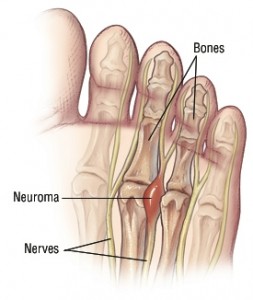Morton's Neuroma
What is it?
Morton's neuroma is the common name given to the nerve irritation that is found in the ball of the foot that may or may not be accompanied by an inter-metatarsal bursae (a bursa-neuromal complex). It is often associated with inflammation or degeneration and often occurs with constant pressure or irritation of the nerve from the surrounding bony structures or local bursas (fluid filled sacs). Morton's Neuroma can cause symptoms such as a sharp pain, burning even a lack of feeling in the ball of the foot and associated toes. Morton's Neuroma is often called an "interdigital" neuroma because it is found in the nerves that run between the knuckles at the base of the toes of the foot. The area of the foot that can be affected include the area between the base of the 3rd and 4th toes or the 2nd and 3rd toes. |
Symptoms associated with a neuroma include a dull burning sensation radiating towards the toes, a cramping feeling, or even a stinging, tingling sensation that can be described as being similar to an electric shock. It is often worse when wearing shoes with most people finding the pain disappears when removing their shoes.
Note: Mortons Neuroma is a common misdiagnosis for metatarsal phalangeal joint pathology as neurological symptoms do not always make a diagnosis of neuroma. It is however possible to be suffering from a bursa-neuronal complex, capsulitis and/or a plantar plate tear all at the same time!
What causes it?
Morton's Neuroma is a caused by pressure, abnormal function/motion or an imbalance in the structure of the foot such as flat feet, that causes an abnormal pressure on the structures and the nerves in the ball of the foot. It most commonly affects the nerve that goes to the 2nd 3rd or 4th toes. The squeezing of the nerve from abnormal motion leads to a protective thickening of the sheath that protects the nerve. Symptoms of Morton's Neuroma often occur during or after activities that cause a sidewards squeezing of the ball of the foot or from pressure such as walking, standing, or playing sport. Since squeezing is a common cause of the condition, shoes such as pointed toes or high heels can often lead to a neuroma. Shoes that are constricting, even tight sneakers, can pinch the nerve between the toes, causing inflammation and pain.
How is it treated?
The good news is that in many cases the pain can often be relieved with the right pair of softer styled orthotics or insoles (even in those cases where there is concurrent plantar plate tears and capsulitis). Whilst pain relief can often be achieved with a little help, there is no magic cure to speeding up the healing process so one must take care of their feet for 6-12 weeks.
As a rule of thumb a neuroma should always be treated conservatively where possible. This means icing and resting the area, trying to remove the causative factors, and providing postural control and support via metatarsal domes or, if needed, specialised pre-made or custom made orthotics.
Treaments may include:
- Wearing wider shoes to reduce the squeezing force on the foot.
- As listed above, we can add a specially made padding to shoes to offload the pressure on the ball of the foot (called a metatarsal dome)
- Addressing the foot and lower limb biomechanics. This involves looking at foot stability and if needed prescribing an orthotic device to correct your foot position.
- Anesthetic & Cortisone injections. This is done when the above treatments are insufficient. The trauma is sometimes so great that conservative treatment cannot control the inflammation or cause of the pain. A series of injections are performed to control the inflammation or to temporarily settle the nerve. An ultrasound and cortisone injection can be prescribed by your podiatrist.
- Surgery. This is the last and most permanent course of action. This surgery is used as a last resort as it often comes with a series of side affects including the risk of making the pain worse. This surgery can be performed by Orthopedic surgeons as well as Podiatric surgeons.
Related Articles
- Orthotics
- Over Pronation (flat feet)
- Sports Centre
- Podiatry
- Sports Podiatry



